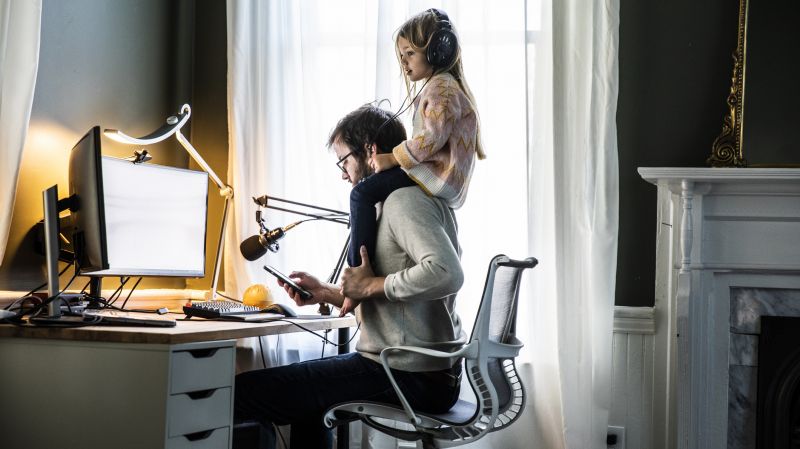The Uncomfortable Questions Posed by Remote Work
From electronic monitoring to random home safety checks, there’s a lot to the remote workplace we haven’t thought through

Much has been written about remote work throughout the pandemic, creating the perception that remote work is the new normal. But is it? This is an incredibly important issue with very significant implications, calling for data-driven answers. So what do the data tell us?
Yes, there was a substantial increase in remote working during the pandemic, and data from different countries bear this out. In Canada, for example, only four per cent of employees aged 15 to 69 worked most of their hours from home in 2016. By January 2021, at the height of the pandemic, 32 per cent did so.
Two surveys estimate the rates to be lower in the United States than in Canada, with between 22 and 25 per cent of U.S. workers involved in remote work during the pandemic. In the United Kingdom, 25.9 per cent of people surveyed in 2020 indicated that they had worked from home, up from 12.4 per cent in 2019. These data provide more of a realistic baseline of the prevalence of remote working than media reports might have you believe.
Going one step further puts the prevalence of remote working arrangements into an even sharper perspective. As the report of remote work in the United Kingdom notes, the 25.9 per cent they identified did not necessarily work remotely all the time but had worked from home “at some point before they responded to” the survey.
An unfair divide
What might be the situation in the future? Mehdi and Morisette used their data to estimate worker preferences for remote working after the pandemic. Instead of focusing on the number of people who say they would want to do so, they estimated the total number of hours people would prefer to work from home, information that is more nuanced and would be much more useful for organizational planning. On average, Canadian employees aged 15 to 69 would prefer to spend 24 per cent of their working hours at home.
As with so many averages, however, the range tells a more interesting story. Employees with a high school diploma or less would prefer to spend nine per cent of their working hours at home. Yet those with at least an undergraduate degree would prefer to work from home for 44 per cent of their total hours.
Therefore, we need to be cautious about our future predictions for several reasons. First, the number of people who get to work from home may be much less than either idealists or the prophets of doom about the future of work would have us believe.
Second, and more troubling, if these preferences turned into actual remote-work patterns, access to remote work will become a new status symbol at work. Employees with advanced education, specialized skills and more lucrative compensation would again have the privilege of working from the safety of their own homes, with the accompanying time and financial savings from less commuting. In contrast, employees with less education, fewer skills and less compensation would be forced to work in their traditional workplaces—where the chances for viral spread during a pandemic is greater—and spend more time and money on commuting.
Taken together, what we would see are workplaces with yet one more status division between employees, when organizations could be focused on rising to the challenge to build back fairer. This is critical given our understanding of the extensive negative consequences when fairness goes awry.
Issues to resolve
Irrespective of the number of people who end up working from home in the future, substantial questions will need to be answered by organizations if this model is to be implemented successfully. Clearly, the best time to ask these questions is before any implementation decisions are made.
To understand the scope of the challenges and changes that may well emerge, will the term workplace even be appropriate if increasing numbers of people work remotely? Questions were raised throughout my recently published book, such as what high-quality leadership entails when leaders and followers no longer work in the same place at the same time, or how multiplex working relationships are developed and maintained when people no longer physically work together.

Many more questions will emerge. What happens to the many benefits from the sense of autonomy when large-scale corporations tell staff they have to work from home for at least a part of the week, or when they introduce electronic monitoring of remote employees? What does informal socialization of newcomers look like in an environment of remote work? In addition, how will organizations support remote employees who simultaneously care for children (or elderly parents or relatives)? After all, a survey of employees in the middle of the pandemic showed that balancing work and family was the most difficult issue for employees with children, so much so that, as one employee reminded us, “for a stressed-out parent, W.F.H can quickly turn into W.T.F.!”
With regard to safety, management in many jurisdictions is required to inspect the workplace on a monthly or annual basis for safety reasons. In a remote work model, does management have the right to enter employees’ homes for routine safety inspections? Relatedly, randomly selected government safety inspections reduce workplace injuries: does the government have the right to enter employees’ homes for random safety inspections? Who pays for the IT equipment and furniture people use at home? Does this mean that organizations will double their equipment budgets for remote workers? How will supporting two workplaces factor into productivity analyses?
At a very different level, even challenges to taxation systems will emerge. Remote work means you can live in one country but work in a different one. Where do you pay your taxes? At this stage, you will almost certainly be taxed in the jurisdiction in which you work. Is this fair when you receive all your public goods in a different jurisdiction?
These are just some of the questions and issues that organizations will need to confront if they are to successfully embrace remote work.
Julian Barling is the Borden Chair of Leadership and Stephen Gyimah Distinguished University Professor at Smith School of Business. This essay is adapted from Brave New Workplace: Designing Productive, Healthy, and Safe Organizations, published recently by Oxford University Press.





